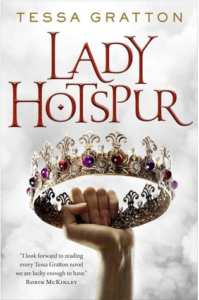I guess you don’t have to come into this having already read Tessa Gratton’s The Queens Of Innis Lear, but I’m betting it would be super helpful. And I say that as someone who spent a lot of time looking up both that novel as well as the Shakespearean plays that inspired them (Henry IV Part I for this one, King Lear for its predecessor) in the course of reading this. Which research, along with historical asides, reminded me of all the reasons Shakespeare’s plays annoy me. Massaging the truth for drama is one thing, but then pretending that drama is the truth is quite another. Oh, don’t tell me old Bill was presenting his stuff as fiction, you know well and good he wrote expedient political nonsense.
 But I do love a good retelling, and so to Ms Gratton’s latest. Lady Hotspur is a gender-bending, multiracial fantasy based loosely on Henry IV Part I, which itself was based loosely on real history. Hal, Hotspur and Edmund are all women in this version, and best friends who grow to be at odds when Hal’s mother returns from exile to depose the previous king, Rovassos, who had named Edmund (here renamed Banna Mora) his heir. Hal and Hotspur become lovers but as the duties of nobility tear them away from one another and from Banna Mora, more than just personal conflict arises, as the quest to rule Aremoria begins. There’s prophecy and sex and magic and loads of bloodshed, leading to a lovely, unexpected ending that felt rightfully earned. It’s not exactly a spoiler to say that you can understand why Hal forgives Banna Mora, even tho I personally would not have — then again, Hal is a good prince (eventually) and I’m a grumpy book critic.
But I do love a good retelling, and so to Ms Gratton’s latest. Lady Hotspur is a gender-bending, multiracial fantasy based loosely on Henry IV Part I, which itself was based loosely on real history. Hal, Hotspur and Edmund are all women in this version, and best friends who grow to be at odds when Hal’s mother returns from exile to depose the previous king, Rovassos, who had named Edmund (here renamed Banna Mora) his heir. Hal and Hotspur become lovers but as the duties of nobility tear them away from one another and from Banna Mora, more than just personal conflict arises, as the quest to rule Aremoria begins. There’s prophecy and sex and magic and loads of bloodshed, leading to a lovely, unexpected ending that felt rightfully earned. It’s not exactly a spoiler to say that you can understand why Hal forgives Banna Mora, even tho I personally would not have — then again, Hal is a good prince (eventually) and I’m a grumpy book critic.
That said, it can feel like a slog to get to said ending. There is A LOT going on, with a magic system and folklore that constantly reference TQoIL, such that I almost hesitate to call this a standalone novel. Ms Gratton does have a gift for characterization, where a character she presents as being deeply annoying can grow to become not only understandable but heroic. This was especially true for Hal: I spent a long time feeling impatient with her sense of self-pity and had to remind myself that she was still a teenager, and one who hadn’t expected to have such responsibility thrust upon her. I was thus pleasantly surprised at how well she turned out. I do rather wish that some of the time spent on her romance with Hotspur had been spent on fleshing out her relationship with her mother instead, as I was actually quite startled when she expressed her devotion to Celedrix after spending so much of the book trying to disappoint her. I also wish I could’ve sympathized more with Banna Mora’s outright selfishness and sense of privilege, but again, Hal is a far better person than I am.
If you dig medieval fantasy, Celtic-based magic and quasi-history, you could do worse than to pick up Lady Hotspur. If you want queer, feminist stories of warfare and leadership that affirm many facets of a healthy sexuality, definitely pick up Lady Hotspur.
And oh my God, that cover. The artist for this and TQoIL was inspired.
